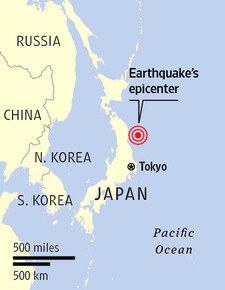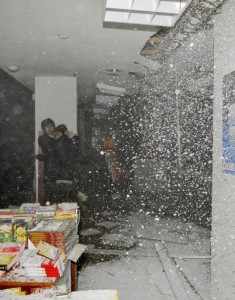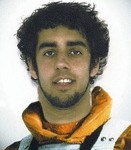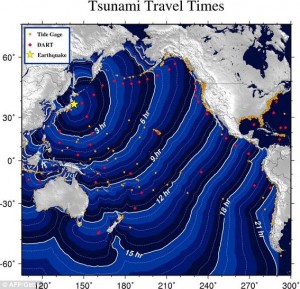Japan Rocked by an 8.9-Magnitude Earthquake
On Friday, at 2:46 P.M. local time, an 8.9-magnitude struck off the coast of northern Japan. According to the United States Geological Survey, the epicenter of the quake was 231 miles away from the capital city of Tokyo. Aftershocks continue to rock the area, with some up to 7.0-magnitude, which is a sizable earthquake in its own right.
As of now, 4 million people are without electricity in Japan. Nuclear power plants have been shut down automatically in response to the quake, while planes, trains, and most other forms of public transportation have ground to a halt. Fires erupted from many buildings, including an oil refinery that went up in flames. Buildings shook violently in Tokyo, as people poured out into the streets after the quake hit. Many people are congregating in public areas, such as parks, wondering what they should be doing and what happens next.
 This is the 5th-largest tsunami recorded in the world since 1900. The largest ever was a 9.5-magnitude quake that struck Chile in May of 1960. It would be one thing if there was just the earthquake to deal with, but of course aftershocks have, and will continue, to follow the initial quake. Obviously aftershocks are problematic, especially in this case, as so far the the tremors that follow the main quake have not been small. Click here to see the seismic activity in the area since the quake.
This is the 5th-largest tsunami recorded in the world since 1900. The largest ever was a 9.5-magnitude quake that struck Chile in May of 1960. It would be one thing if there was just the earthquake to deal with, but of course aftershocks have, and will continue, to follow the initial quake. Obviously aftershocks are problematic, especially in this case, as so far the the tremors that follow the main quake have not been small. Click here to see the seismic activity in the area since the quake.
The biggest problem now facing Japan, and many parts of the Pacific, are tsunamis. These titanic walls of water are caused when the earth quakes violently, sending a wave of energy through the ocean. The water then surges over land and destroys everything in its path. As you can see in the videos below, cars, houses, boats, people, and buildings were swept away by this unstoppable force of nature. The footage looks like deleted scenes from The Day After Tomorrow.

As of right now, various warnings are being issued throughout the Pacific as predictions are being made about the possible size of these waves. Japan has reported that the port city of Sendai was crushed by a 33-foot wave (video below). This is cause for great concern as tsunami warnings ring out across island chains and coastlines from Russia to Mexico. Low-lying islands and atolls are at risk of being completely engulfed by the waves, as many rest barely above sea level. Waves of the size being predicted will roll right over these places and keep on going.
According to CNN International meteorologist Ivan Cabrera, “When you jump a magnitude from 7 to 8, it’s not 10 times stronger, it’s a 1,000 times stronger. With an … earthquake that shallow, that close to shore, there will be more than one tsunami.”
Tsunami waves can move at up to 800 kilometers (497 miles) per hour. Due to the speed that waves sent out from the epicenter of the quake, it can be predicted when the tsunami will reach distant shores. With a quake this big, the effects will be felt throughout the world as aftershocks and waves continue for hours and days after the initial quake.
Waves from this tsunami are expected to reach the Hawaiian Islands at 3 A.M. local time, which is about 8 A.M. on the East Coast. People on the island are currently flocking to gas stations and grocery stores, attempting to stock up and prepare for whatever is coming. As I type this, sirens are blaring in Honolulu, alerting people of the impending uprising the ocean has in store for them. People in coastal areas are merged to head inland or find higher ground. A tsunami warning was also issued for Oregon, California, and Washington state. Click here to see the list of other countries where tsunami warnings have been issued.
This earthquake is comparable to the 9.0-magnitude quake that struck Indonesia in 2004. The tsunami resulting from that one killed over 250,000 people in 14 countries and caused $10 billion worth of damage. Considering the position of this quake; the depth at which it occurred, its proximity to the coast line, and its relative position in the Pacific, we could be looking at similar numbers after all is said and done.
This situation is developing, and while much has happened so far, the world waits with bated breath to see which countries get hit by the tsunami, and how hard. Tune into your normal news sources for the most recent and up-to-date news on this story as it develops. With the tsunami due to arrive in Hawaii in the next few hours, and then the West Coast after that, the United States involvement in this story is just beginning.

